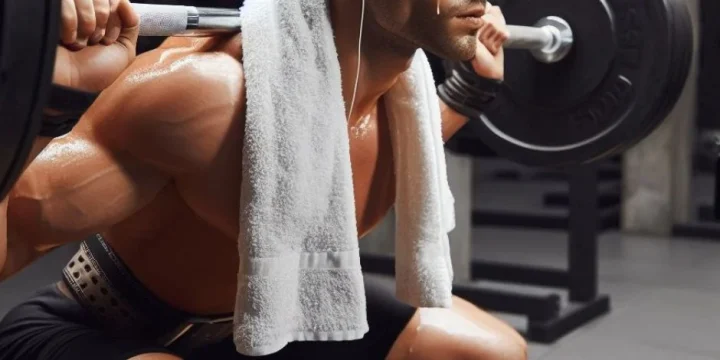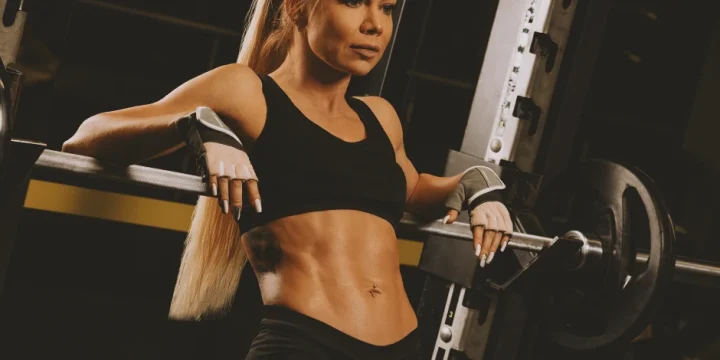Belt squats provide a targeted approach to strengthening your lower body muscles, including the legs, glutes, and core. Regardless of your athletic background, mastering the proper execution of belt squats can effectively enhance these muscle groups.
The exercise shifts the center of gravity, enabling us to handle heavier weights safely and preventing knee and back injuries.
As an experienced and certified fitness expert, I created this comprehensive guide to help my clients perform belt squats with proper form, outlining the benefits and revealing my preferred alternatives and variations.
Quick Summary
- To perform belt squats, a variation of the traditional squat, securely position a hip belt around your waist and attach it to a belt squat machine, then perform squats with a focus on hip extension and reduced spinal strain.
- Belt squats target key lower body muscles, including the hamstrings, quadriceps, and glutes, while also engaging trunk stabilization muscles for balance and posture.
- A study published on the National Center for Biotechnology Information website found that belt squatting decreased lumbar erector impulse by 45.4% and peak activation by 52.0% compared to back squatting, offering a safer alternative for those with back concerns.
- Drawing from my extensive experience in the field, I can confidently say that belt squats are a valuable addition to strength training regimens, offering a safe and effective way to build lower body muscle mass without the spinal compression associated with traditional squats.
What Is a Belt Squat?

The belt squat is a variation of the squat that primarily targets the legs while reducing strain on the spine.
The concept of hip belt squats dates back to the 1970s, and they were further popularized by the belt squat machine created by Louie Simmons of Westside Barbell after experiencing a back injury.
"In our gym, we coach weightlifting, powerlifting, sports performance, and gen pop, and I would say across the board every single member uses the belt squat machine."
- Travis Mash, Head Coach at Mash Elite Performance
How To Perform a Belt Squat
Follow these steps while performing belt squats:
- Securely position the hip belt around your waist and attach it to the belt squat machine.
- Stand with your feet in your regular squat stance, ensuring proper alignment.
- Breathe in, engage your core, and lift the weight off the rack.
- Perform a squat with excellent form, aiming for maximum depth.
- Smoothly reverse the movement, extending your hips and legs.
- Exhale as you rise, or pause at the top to take a breath.
- Inhale and repeat the exercise for the desired number of repetitions.
Muscles Worked

According to one of the studies from the PubMed website, belt squats primarily work the same muscle groups as the barbell squat, including the hamstrings and quadriceps [1].
The glutes and trunk stabilization muscles are also engaged to a lesser extent during belt squats.
These are the muscle groups worked in more detail:
- Hamstrings: Belt squats target and work the hamstring muscles at the back of the thigh. This helps improve strength and stability in the posterior legs.
- Quadriceps: The quadriceps muscles in the front of the thigh are also engaged during belt squats. The exercise contributes to building strength and definition in the quadriceps.
- Glutes: While not the primary focus, belt squats activate the gluteal muscles, including the gluteus maximus and medius. This contributes to lower body development and enhances hip stability.
- Trunk Stabilization Muscles: Belt squats require the engagement of trunk stabilization muscles, including the core muscles, obliques, and erector spinae. According to another study from the National Center for Biotechnology Information website, these muscles help maintain balance and proper posture during the exercise [2].
Benefits of Belt Squats

Having integrated belt squats into numerous training routines, I can attest to their effectiveness as a compound lift that offers a multitude of benefits. My clients have experienced significant improvements in lower body muscle mass, reduced spinal compression, and enhanced training efficiency.
Some of them include:
- Builds lower body muscle mass: The belt squat is particularly effective for muscle growth in the legs because it focuses on hip extension.
- Limits spinal compression and lumbar loading: With minimal upper body involvement, the exercise resembles a leg press or hack squat, offering stability and balance advantages similar to the barbell squat while exerting less strain on the spine [3].
- Benefits lifters with limited shoulder mobility: By removing the shoulders from the equation, it accommodates weightlifters with restricted shoulder movement.
- Reduces elbow and wrist extension: The hip belt squat eliminates strain on the elbows and wrists, providing a lower body workout without discomfort in those areas.
- More training with less fatigue: With the reduced strain on the spine, the proper hip belt form allows for intense lower-body training while minimizing fatigue and promoting faster recovery.
- Better for lifters with trunk muscle injuries: The exercise targets the quads in hip extension while minimizing pressure on the core, making it a suitable lower-body exercise for weightlifters recovering from core muscle injuries [4].
The Best Variations and Alternatives

While traditional belt squat machines are effective, several belt squat alternatives and variations can provide similar benefits.
Ranging from free-standing squats, belt sumo squats, split squats, belt squats, bent-over rows, barbell squats, Romanian deadlifts, and landmine squats, here are some of my favorite belt squat alternatives and variations.
1. Belt Squat Romanian Deadlift
Using a belt for Romanian deadlifts is not recommended as it reduces their effectiveness on posterior muscles. Instead, use a straight bar attachment and perform them like a barbell.
This can be a fun variation combined with bent-over rows for challenging supersets.
Here's how to perform this variation:
- Position yourself with your feet hip-width apart and hold the barbell above your shoelaces.
- Lift the barbell until your hips and knees are fully extended, using a double overhand grip slightly wider than hip width.
- Initiate a Romanian deadlift by pushing your hips back and leaning forward, allowing the bar to lower below knee level.
- Ensure that your legs are fully extended throughout the movement.
- Get back to the starting position and repeat for reps.
2. Freestanding Belt Squats
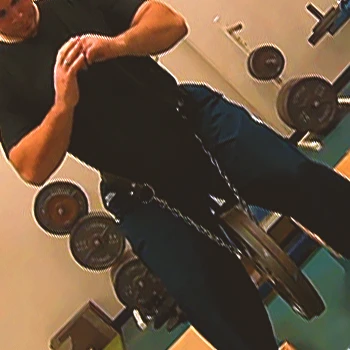
In my experience, freestanding belt squats are a simple and equipment-friendly variation of belt squats. Instead of using dedicated belt squat machines, you attach the belt directly to a dip belt, eliminating the need for additional equipment.
To perform a freestanding belt squat:
- Begin by attaching a dip belt to a long hanging chain.
- Connect plates or kettlebells to the loose end of the chain to create resistance.
- Stand on boxes to create distance from the hanging weight.
- Tighten your abdominal muscles to keep your torso rigid.
- Consider the driving force through your heels as you pick your feet up and stomp down in a squatting motion.
- Gradually increase the resistance as you gain strength.
3. Ranged Trimetric Belt Squats
A ranged trimetric belt squat is a variation of the traditional exercise that focuses on specific depth targets during the squat.
It adds precision and control to the movement, enhancing muscle activation and potential strength gains.
Follow these steps to perform this move:
- Begin by positioning your feet shoulder-width apart on the belt squats machine with your toes pointed forward.
- Lower yourself into a squat, keeping your back straight and knees tracking over your toes.
- Pause at the bottom of the squat, ensuring your thighs are parallel to the floor.
- Slowly rise halfway, maintaining tension in your legs and glutes.
- Lower back down to the bottom position.
- Fully extend your legs to stand up, completing one repetition.
4. Landmine Belt Squat
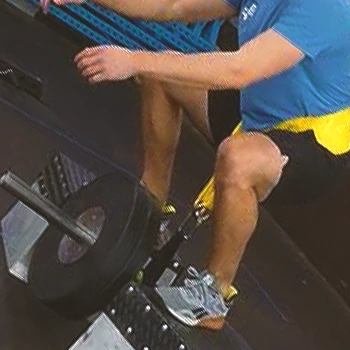
The landmine setup is versatile and is a great variation for belt squats, preferred by many over the belt squat machine.
Set up a proper landmine with a dedicated attachment for optimal results and to avoid weight and force direction issues.
To perform a landmine belt squat, follow these steps:
- Set up a barbell with weights on one end and attach a landmine attachment at the other.
- Place boxes or platforms on either side of the barbell for stability.
- Attach a belt to the landmine attachment and secure it around your waist.
- Position yourself before the barbell, ensuring the weight is balanced and the landmine is securely anchored.
- Squat down, following the curved path the barbell naturally takes due to the landmine attachment.
5. Cable Hip Belt Squat
This hip belt squat variation is a beginner-friendly leg exercise with a cable machine. First, set the pulley system to the lowest level, put on the hip belt, connect it to the pulley, and stand a few feet back.
It's one of many great cable machine leg exercises available.
To perform cable hip belt squats:
- Set up the cable machine with the pulley system at the lowest level.
- Put on the hip belt and attach it to the pulley system.
- Step back a few steps to create tension in the cable.
- Adopt a squat stance with feet shoulder-width apart and maintain good posture.
- Lower yourself into a squat position, bending your knees and hips while keeping your upper body straight.
- Descend until your thighs are parallel to the ground, or as low as is comfortable.
- Pause briefly at the bottom of the squat.
- Push through your heels and extend your knees and hips to return to the starting position, and repeat for reps.
6. Staggered Belt Squats
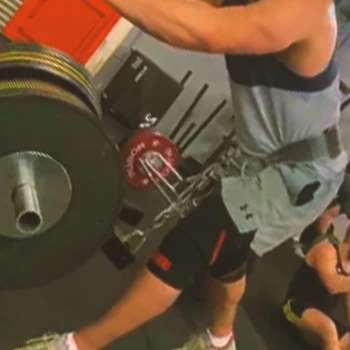
This variation is performed with one foot forward and the other foot positioned behind, which creates an asymmetrical stance and places different demands on the muscles compared to the conventional belt squat.
To perform staggered belt squats:
- Set up the machine with the desired weight.
- Put on the hip belt and secure it around your hips.
- Position your feet in a staggered stance, with one foot slightly forward and the other foot slightly back.
- Keep your torso upright and maintain good posture.
- Lower yourself into a squat position, bending your knees and hips while keeping your back straight.
- Descend until your thighs are parallel to the ground, or as low as is comfortable.
- Push through your heels and extend your knees and hips to return to the starting position, and repeat for reps.

7. Belt Squat Marches
Belt squat marches are a powerlifting-inspired exercise where you stand upright and march in place or perform different movements with one leg unloaded.
It is a warm-up or activation exercise and can be modified with resistance bands for hip flexor and glute stimulation.
Here's how you can do it:
- Position yourself directly above the belt machine.
- Engage your abdominal muscles to maintain a stable and upright torso.
- Focus on generating power from your heels as you lift your feet and forcefully stomp them down in a marching-like action.
- Gradually enhance the upward movement of your knees.
- Perform the exercise for the desired number of repetitions.
FAQs
Do Belt Squats Build Mass?
Yes, belt squats build mass. Belt squats build muscle mass in the quadriceps and hamstrings as effectively as the barbell squat. Although they can contribute to building mass in the glutes, they may not be as effective as back squats.
How Heavy Should You Belt Squat?
How heavy you should belt squat will depend on your experience level. Beginners should aim for around 115 pounds, while the average weight for male lifters is 381 pounds, which is impressive and puts them at an intermediate strength level.
How Has the Historical Development of the Belt Squat Machine Evolved?
The historical development of the belt squat machine has evolved from basic lifting mechanisms to sophisticated equipment designed for targeted lower-body training, enhancing both safety and effectiveness. This evolution reflects advancements in biomechanics and a deeper understanding of strength training needs.
What Does Biomechanical Analysis Reveal About Belt Squat vs. Traditional Squat?
Biomechanical analysis reveals that belt squats place less stress on the lower back and knees compared to traditional squats while effectively targeting the same lower body muscle groups. This makes belt squats a safer and more focused alternative for individuals with joint concerns or back issues.
How Have Case Studies on Rehabilitation Using Belt Squats Demonstrated Their Effectiveness?
Case studies on rehabilitation using belt squats have demonstrated their effectiveness in allowing athletes to maintain lower body strength during recovery from injuries, especially those affecting the back or knees. These studies highlight the belt squat's ability to isolate lower body muscles without putting undue stress on injured areas.
How Can Belt Squats Be Integrated into Athletic Training Programs?
Belt squats can be integrated into athletic training programs as a tool for building lower body strength without the spinal load of traditional squats, making them ideal for athletes in sports requiring leg strength and endurance. This integration offers a balanced approach to strength training, reducing the risk of overuse injuries.
What Do Experts Say About the Role of Belt Squats in Strength Training Regimens?
What experts say about the role of belt squats in strength training regimens is that belt squats play a crucial role in strength training regimens by providing a safe and effective alternative to traditional squats, especially for individuals with back or knee issues. Their inclusion in training programs is seen as essential for a well-rounded approach to lower body strength development.
References:
- https://pubmed.ncbi.nlm.nih.gov/32269663/
- https://www.ncbi.nlm.nih.gov/pmc/articles/PMC7126258/
- https://www.ncbi.nlm.nih.gov/pmc/articles/PMC1479027/
- https://pubmed.ncbi.nlm.nih.gov/2304406/
About The Author
You May Also Like
